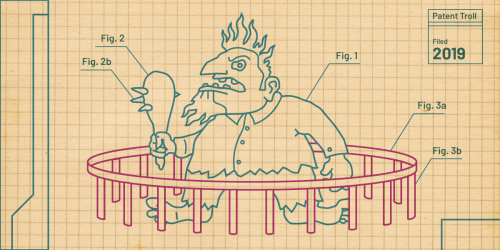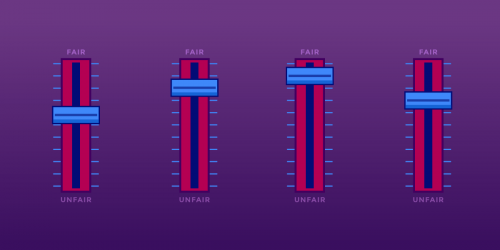Update May 2019: Senator Tillis' office has published language for a draft bill. While the bill no longer references a closed statutory list, or a "practical application test," our concerns about the bill remain.
In recent years, we’ve made major progress getting courts to give full effect to Section 101 of the U.S. Patent Act. That’s the section that defines, and limits, what can get a patent. Section 101 is critical in making sure that only inventions—technological advances attributable to human efforts—can be patented.
Now, key Senators are looking to undo all of that progress and drive the patent system into uncharted territory. Senators Tillis (R-NC) and Coons (D-DE) are pushing ahead with a proposal that will upend more than a century of case law and make the patent system far worse for small innovators and ordinary consumers in the software and health care industries.
Who will benefit most from the proposal? Companies that make money from aggressively licensing and litigating patents, especially in the fast-growing fields of artificial intelligence and medical diagnostics. And, of course, the patent lawyers and law firms who make money representing them.
Not to mention, patent trolls. With Section 101 broken, defendants will have lost a powerful tool for fighting bad patents. Most of the small businesses we profiled in our “Saved by Alice” project would have likely been pushed toward lengthy and expensive trials, rather than fast and fair resolutions, in order to defend against false infringement charges.
While our current Section 101 dates to the 1870s, the words of the law have stayed largely the same since the first U.S. patent law was passed in 1793. Today, Section 101 reads simply:
Whoever invents or discovers any new and useful process, machine, manufacture, or composition of matter, or any new and useful improvement thereof, may obtain a patent therefor, subject to the conditions and requirements of this title.
The Tillis-Coons proposal is aimed squarely at killing the many Supreme Court decisions—Mayo v. Prometheus and Alice v. CLS Bank in particular—that have interpreted Section 101 in ways that promote innovation. Rewriting Section 101 could undermine all of U.S. patent law and would open the door to patents on old and useless ideas as never before.
The newly re-constituted Senate IP Subcommittee, chaired by Tillis, is determined to tweak the patent laws in favor of patent-holders. While the exact language of the subcommittee’s bill isn’t yet available, the bill’s sponsors have published a “patent reform framework” that details, point by point, how they intend to degrade the patent system.
Undermining Section 101
Let’s take a look at each of the framework’s seven points from Senator Tillis' published statement on the framework, starting with the one that describes the most dramatic change:
- "Eliminate, within the eligibility requirement, that any invention or discovery be both 'new and useful.' Instead, simply require that the invention meet existing statutory utility requirements."
Removing the requirement that inventions actually be new and useful upends a fundamental Constitutional principle of patent law. The Constitution grants Congress the power to issue an “exclusive right,” such as a patent, only “[t]o promote the progress of science and useful arts.” The patent system’s entire purpose, in other words, is to encourage technological progress. Allowing patents on things that are neither new nor useful undermines the purpose of the Intellectual Property Clause.
Section 101’s purpose is to weed out patent applications that cannot possibly be inventive. The “existing statutory utility requirements” do not, and cannot, accomplish this. That’s because other parts of U.S. patent laws do not include a specific “utility” requirement. Section 102 and 103 set out requirements for determining whether an invention is obvious in view of pre-existing knowledge in the field—what is known as “prior art”—but courts and the Patent Office apply those requirements extremely narrowly.
It’s especially difficult to invalidate bad software patents under Sections 102 and 103. Because courts and the Patent Office didn’t start granting patents on software alone until the mid-1990s, there is a dearth of patents and patent applications that could be used to invalidate software patents under Sections 102 and 103. And because the code for most software products is not public, it isn’t readily available to others in court challenges.
As a practical matter, a mid-value patent lawsuit costs more than $3 million to litigate through trial. Cases that revolve around Section 101 resolve for a small fraction of that, avoiding the massive costs of discovery, experts, and trial. The Supreme Court’s decision in Alice v. CLS Bank has been a powerful weapon against worthless patents, saving numerous start-ups and small businesses from abusive patent litigation.
That's not all. Senators Coons and Tillis want lawmakers to create a strictly limited list of technologies that can’t get a patent, while placing virtually no limits there on what can get a patent:
- "Define, in a closed list, exclusive categories of statutory subject matter which alone should not be eligible for patent protection."
The reference to a “closed” and “exclusive” list of ineligible categories is a clear effort to prevent the courts from doing their job: interpreting the law. They’ll simply set the default to “patentable” for emerging technologies.
The next point of the framework is clearly pointed at undoing court rulings that have made the patent system better for people who actually build technology:
- "Statutorily abrogate judicially created exceptions to patent eligible subject matter in favor of exclusive statutory categories of ineligible subject matter."
The Supreme Court has consistently rejected patents on uninventive subject matter, like the method of hedging risk in Bilski; the method of determining drug dosage based on blood metabolite levels in Mayo; and the computerized escrow system in Alice. Companies that make money licensing low-value patents want to throw these decisions out, just as district courts are finally applying them. Even the Eastern District of Texas—once the most popular judicial district among patent owners—has started finding patents ineligible [PDF] under 101 at early stages of litigation.
The fourth substantive change would undermine proper patent claim interpretation:
- "Make clear that eligibility is determined by considering each and every element of the claim as a whole and without regard to considerations properly addressed by 102, 103 and 112."
Patent lawyers like to say “the name of the game is the claim.” That’s because the claim is the part of a patent that actually defines the “invention” that others are prevented from using. And it is the “claim as a whole” that’s considered the invention, not any particular element by itself.
But that doesn’t mean courts can’t consider the individual elements of a patent claim. In fact, it’s often critical that they do so. For example, the patent in Alice included a “data storage unit,” which the court considered “purely functional and generic,” and therefore rejected this element—because it didn’t have the “inventive concept” that Section 101 requires.
By telling courts not to look at the elements of a patent claim, Tillis and Coons are effectively telling courts to ignore the words the claim actually uses to describe the invention. Considering the claim “as a whole” just means ignoring what the individual words in the claim actually mean.
False Reassurance
The proposed framework also includes three points that are meant to assuage potential critics. Here's one of them:
- "Ensure that simply reciting generic technical language or generic functional language does not salvage an otherwise ineligible claim."
This point attempts to show that the bill won’t open the floodgates to worthless patents. It’s true that generic language should not confer patent-eligibility, but no one should have confidence that this language will have any practical effect if enacted. Keep an eye on the big picture: this is part of a legislative proposal intended to allow patents on old and useless technologies.
In any case, sometimes “generic technical language” isn’t the problem. For example, courts rejected a patent in DietGoal Innovations LLC v. Bravo Media LLC, which claimed “a computerized method of selecting meals,” because the method was nothing but “conventional and quotidian tasks.” Sometimes, courts just use common sense to rule that conventional everyday tasks aren’t “inventive.”
They'll also create a new test:
- "Create a 'practical application' test to ensure that the statutorily ineligible subject matter is construed narrowly."
We already have a test to make sure each and every patent is worth the public cost of a 20-year monopoly: Section 101, as interpreted by the Supreme Court. There is no need for a new test to determine whether a patent is eligible.
This point of the framework makes clear what the Tillis-Coons proposal is really trying to do: ensure that courts and the Patent Office do not reject patent applications that should have been rejected.
Then there's one last point—which actually is the first point in the Tillis-Coons press release—that's meant to make this radical change to the patent system seem less so:
- "Keep existing statutory categories of process, machine, manufacture, or composition of matter, or any useful improvement thereof."
Any version of Section 101 that defines patent-eligible inventions to include things that are useful, but not new, would change the categories of eligible subject matter we have now.
This is another attempt to understate the radical changes being proposed in this bill. Scrapping the words “new and useful” would be an unprecedented departure—as the patent owners pushing this legislation well know.
According to their press release, Senators Tillis and Coons will be introducing a bill later this year. If the bill looks anything like this proposal, it will be a handout to patent trolls and other abusers of the system. If Congress is serious about ensuring that the patent system promotes innovation, it must listen to the people who work every day in technology and medicine—not just to companies that hold thousands of patents.









